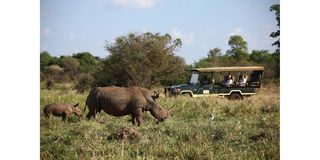The mighty lions of Meru

Elsa's Kopje - activities - game drive - rhino sanctuary - white rhino with baby. Photo | Pool
What you need to know:
It’s thanks to the efforts of Born Free and Kenya Wildlife Service that lions in the Meru National Park have increased in the last eight years
A red moon rises from the long range of the Nyambene Hills in the western sky, catching us unaware that we’re watching a lunar eclipse from the wilds of Meru that was the home of one of the world’s most famous lioness, Elsa of the Born Free fame. As the red moon travels higher into the ethereal space, a lion roars, his sound carried for miles around.

Elsa's Cottage. Photo | Pool
We’re at Elsa’s Kopje, the first lodge built inside the park after the two-decade poaching in the park in the 1980s and 1990s. Elsa, whose story is narrated in Born Free written by Joy Adamson, broke the conventional thought that wild animals raised by humans could never be returned to the wild. Elsa did – straddling two worlds – that of the wild and with the Adamsons – opening a new chapter in wildlife conservation. Sadly, Elsa died of tick fever in 1961 at the age of five, leaving behind three cubs named Jepha, Gopa (the scared one) and Little Elsa, who after her death were taken to the Serengeti in Tanzania.
With the opening of this stunning camp moulded into Mughwango Hill, above the site of George Adamson's original camp where he raised and released orphan lions and which Elsa might have considered her own, visitors began to visit the park again – now assured of safety.
We’re soaking in the luxury of the camp. The suites boast framed posters and pictures of the Born Free film, including the epic picture of Joy meeting the late Queen Elizabeth, wearing an exact evening gown, something that was not a done thing. On the verandah, sunken baths entice one to bathe under open skies where the rock hyraxes sun themselves while below, their gigantic relatives browse on the trees and shrubs – the elephants.
In the Wilds of Meru
Mary Wykstra, the founder of Action for Cheetahs in Kenya, returns from an early morning game drive excitedly, to state, “We saw not only two lionesses with cubs, but also a pair of resident maneless males.”
Today Meru boasts a healthy population of some 80 lions.
“It’s thanks to the efforts of Born Free and Kenya Wildlife Service that lions in the Meru National Park have increased in the last eight years,” states Wykstra.
She continues to give the fascinating spiel of Meru’s rebound. “In 2014, it was feared that lions would no longer roam the range that the famous Elsa once did. Then, Meru was stocked with lions from the surrounding community areas together with the antelopes for the lions to prey upon.”
Sundowner on the Kopje
After a sumptuous lunch, we’re off for a late afternoon game drive driving across the Rojewero River, that is one of the 14 rivers flowing through Meru National Park which also boasts the Tana, Kenya’s longest river.
The five-year drought has burnished the grass – save for the vegetation along the rivers lined by the forked doum palms, and the acacias with the baobabs.
It’s easy to see why Joy called Meru the Garden of Eden. It’s beautiful. As dusk approaches, we’re at the foot of another kopje (rocky outcrop) coloured copper by the setting sun behind the Nyambene’s. The hills give life to the park from where the rivers originate.
As we reach the top of the hill, a surprise awaits us. It’s sundowners looking over the plains where Elsa once roamed and later Pippa the cheetah that Joy brought to Meru – again to return to the wild to live free forever.

Sundowners on a Kopje in Meru National Park. Photo | Pool
More on Meru
Elsa’s Kopje is in the heart of the park, small and exclusive. Look out for special offers to treat yourself.
Getting there:
- An hour’s flight with Safarilink or Air Kenya from Nairobi’s Wilson Airport.
- Or drive (app 7 hours – 300 km from Nairobi) around the mountain (Kenya) via Embu or via Nanyuki. Via Embu is scenic but with lots of curves and bends.
- You need a sturdy 4-wheel drive.
- 2 nights is the minimum to explore the park, three nights are better to venture into Kora National Park and the Tana River crossing over 90-metre-long Adamson’s steel bridge over the rapids where the cable bridge built in 1965 still stands minus the cable car.
- Or combine Meru with the northern circuit like Samburu, Laikipia.
- Check Kenya Wildlife Service website for updated park fees.
- On a budget: KWS has campsites and self-catering family houses and bandas.
Check out Born Free website, founded by Born Free actors to protect wild species and rescue animals from suffering.
Since the release of Born Free in 1966, 90 per cent of the world’s wild lions have been lost. Today, there are only 20,000 left in Africa.
Good news: According to the National Recovery and Action Plan for Lion and Spotted Hyena in Kenya (2020-2030), lions have increased by 25 percent to 2,489 from 2,000.
The challenge today for all wildlife is – space.
www.rupitheafricantrotter.com




